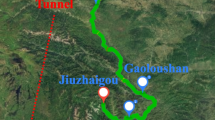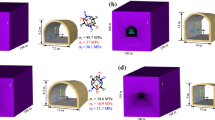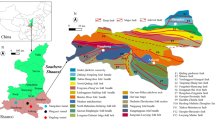Abstract
There are multiple hazard inducers brought about by geological conditions and man-made conditions during the construction of soft rock tunnels in difficult and dangerous mountainous areas, all of which have result in various challenges for the builders. Based on the Jiuzhaigou-Mianyang Expressway (JME), located on the eastern edge of the Qinghai-Tibet Plateau and the northwestern edge of the Sichuan Basin, many on-site investigations and monitorings of surrounding rock pressure and structural mechanical behavior have been conducted on the soft rock tunnels with different hazard inducers, including layered rock tunnels, tunnels strongly affected by underground water and rainwater, tunnels that cross fault fracture zones, and twin tunnels with small clear distance. The results show that the failure characteristics and mechanical behavior of structures are different for different disaster inducers. Layered rock mass leads to asymmetry of structural failure and mechanical behavior; abundant groundwater and a complete rainfall runoff system reduce the self-bearing capacity of surrounding rock; tunnel failure and structural stress through fault zones are generally concentrated at the vault and spandrels with poor stability; the approaching excavation with small clear distance will cause secondary disturbance to the middle rock column, resulting in a prominent decrease in the structural stability of the middle rock column, which may seriously lead to collapse. In addition, the secondary lining of these tunnels gradually becomes the main load-bearing structure during the pressure release of the surrounding rock.





























Similar content being viewed by others
References
Bian K, Liu J, Liu ZP, Liu SG, Ai F, Zheng XQ, Ni SH, Zhang W (2019) Mechanisms of large deformation in soft rock tunnels: a case study of Huangjiazhai Tunnel. Bull Eng Geol Environ 78:431–444
Cao CY, Shi CY, Lei MF, Yang WC, Liu JW (2018) Squeezing failure of tunnels: a case study. Tunn Undergr Space Technol 77:188–203
Chen WF (1981) The mechanics of soils — an introduction to critical state soil mechanics. Eng Geol 17:80–81
Chen Z, Burchfiel BC, Liu Y, King RW, Royden LH, Tang W, Wang E, Zhao J, Zhang X (2000) Global Positioning System measurements from eastern Tibet and their implications for India/Eurasia intercontinental deformation. J Geophys Res-Solid Earth 105:16215–16227
Chen ZQ, He C, Xu GW, Ma GY, Wu D (2019) A case study on the asymmetric deformation characteristics and mechanical behavior of deep-buried tunnel in phyllite. Rock Mech Rock Eng 52:4527–4545
Chen ZQ, He C, Yang WB, Guo WQ, Li Z, Xu GW (2020) Impacts of geological conditions on instability causes and mechanical behavior of large-scale tunnels: a case study from the Sichuan-Tibet highway, China. Bull Eng Geol Environ 79:3667–3688
Chen ZY, Shi C, Li TB, Yuan Y (2012) Damage characteristics and influence factors of mountain tunnels under strong earthquakes. Nat Hazards 61:387–401
Clark M, Royden L (2000) Topographic ooze: building the eastern margin of Tibet by lower crustal flow. Geology 28:703–706
Dalgıç S (2000) The influence of weak rocks on excavation and support of the Beykoz Tunnel, Turkey. Eng Geol 58:137–148
Deng B, Liu SG, Li ZW (2009) Uplifting characteristics in Eastern Margin area of Tibetan Plateau: evidence from low-temperature thermochronology. J Quat Sci 29:574–586
Elwood DEY, Martin CD (2016) Ground response of closely spaced twin tunnels constructed in heavily overconsolidated soils. Tunn Undergr Space Technol 51:226–237
Feng C, Bangshen QI, Zhang P, Sun D, Meng J, Niu L, Wang M, Tan C, Chen Q (2018) Crustal stress field and its tectonic significance near the Longmenshan fault belt, after the wenchuan ms8. 0 earthquake. J Geomech 24:439–451 (in Chinese)
Feng XT, Xu H, Qiu SL, Li SJ, Yang CX, Guo HS, Cheng Y, Gao YH (2018b) In situ observation of rock spalling in the deep tunnels of the China **** Underground Laboratory (2400 m Depth). Rock Mech Rock Eng 51:1193–1213
Guo QL, Wang CH, Ma HS, Wang CG (2009) In-situ hydro-fracture stress measurement before and after the Wenchuan Ms8. 0 earthquake of China. Chinese J Geophys 52:1395–1401
Hoek E, Guevara R (2009) Overcoming squeezing in the Yacambú-Quibor Tunnel, Venezuela. Rock Mech Rock Eng 42:389–418
Huang RQ, Li YR, Qu K, Wang K (2013) Engineering geological assessment for route selection of railway line in geologically active area: A case study in China. J Mt Sci 10:495–508
Hubbard J, Shaw J (2009) Uplift of the Longmen Shan and Tibetan plateau, and the 2008 Wenchuan (M= 7.9) earthquake. Nature 458:194–197
King RW, Shen F, Clark Burchfiel B, Royden LH, Wang E, Chen ZL, Liu YP, Zhang XY, Zhao JX, Li YL (1997) Geodetic measurement of crustal motion in southwest China. Geology 25:179–182
Li T, Lyu L, Duan H, Chen W (2016) Water burst mechanism of deep buried tunnel passing through weak water-rich zone. J Cent South Univ 47:3469–3476
Li TB (2008) Failure characteristics and influence factor analysis of mountain tunnels at epicenter zones of great Wenchuan earthquake. J Eng Geol 16:742–750 (in Chinese)
Li XH, Li DX, ** XG, Gu YL (2005) Discussion on influence of initial support to stability and deformation of surrounding rock mass in soft rock tunnel. Rock Soil Mech 26:1207–1210
Lin DM, Yuan RM, Shang YJ, Bao WX, Wang KY, Zhang ZJ, Li K, He WT (2017) Deformation and failure of a tunnel in the restraining bend of a strike–slip fault zone: an example from Hengshan Mountain, Shanxi Province, China. Bull Eng Geol Environ 76:263–274
Liu WW, Chen JX, Luo YB, Chen LJ, Shi Z, Wu YF (2021) Deformation behaviors and mechanical mechanisms of double primary linings for large-span tunnels in squeezing rock: a case study. Rock Mech Rock Eng 54:2291–2310
Meng LB, Li TB, Jiang Y, Wang R, Li YR (2013) Characteristics and mechanisms of large deformation in the Zhegu mountain tunnel on the Sichuan-Tibet highway. Tunn Undergr Space Technol 37:157–164
Ministry of Transport of PRC (2018) Code for Design of Road Tunnels. China Communication Publisher Ltd, Bei**g
Pan GT, Wang LQ, Li RS, Yuan SH, Ji WH, Yin FG, Zhang WP, Wang BD (2012) Tectonic evolution of the Qinghai-Tibet Plateau. J Asian Earth Sci 53:3–14
Pereira LC, Lana MS (2013) Stress–strain analysis of buckling failure in phyllite slopes. Geotech Geol Eng 31:297–314
Qin XH, Chen Q, Tan C, An Q, Wu M, Feng CJ (2013) Analysis of current geostress state and seismic risk in southwest segment of Longmenshan fracture belt. Chin J Rock Mech Eng 32:2870–2876 (in Chinese)
Su K, Cui J, Zhang Z (2015) Method of choosing initial supporting time during tunnel excavations. J Cent South Univ 46:3075–3082
Sun XM, Zhao CW, Tao ZG, Kang HW, He MC (2021) Failure mechanism and control technology of large deformation for Muzhailing Tunnel in stratified rock masses. Bull Eng Geol Environ 80:4731–4750
Tian HM, Chen WZ, Tan J, Wang H, Tian T (2011) Study of reasonable support scheme for soft rock tunnel in high geostress zone. Chin J Rock Mech Eng 30:2285–2292 (in Chinese)
Wang YC, **g HW, Su HJ, **e JY (2016) Effect of a fault fracture zone on the stability of tunnel-surrounding rock. Int J Geomech 17:04016135
Wang Z, Yao WJ, Cai YQ, Xu B, Fu Y, Wei G (2019) Analysis of ground surface settlement induced by the construction of a large-diameter shallow-buried twin-tunnel in soft ground. Tunn Undergr Space Technol 83:520–532
Xu GW, He C, Wang J, Zhang JB (2020) Study on the damage evolution of secondary tunnel lining in layered rock stratum. Bull Eng Geol Environ 79:3533–3557
Yang JP, Chen WZ, Zhao WS, Tan XJ, Tian HM, Yang DS, Ma CS (2017) Geohazards of tunnel excavation in interbedded layers under high in situ stress. Eng Geol 230:11–22
Zhang JQ, Li SC, Zhang QS, Zhang X, Li P, Wang DM, Weng XJ (2019a) Mud inrush flow mechanisms: a case study in a water-rich fault tunnel. Bull Eng Geol Environ 78:6267–6283
Zhang YJ, Su K, Qian ZD, Wu HG (2019b) Improved longitudinal displacement profile and initial support for tunnel excavation. KSCE J Civ Eng 23:2746–2755
Zhou ZH, Chen ZQ, He C, Kou H (2021) Investigation on the evolution characteristics and transfer mechanism of surrounding rock pressure for a hard-rock tunnel under high geo-stress: case study on the Erlang Mountain Tunnel, China. Bull Eng Geol Environ 80:8339–8361
Funding
This research was supported by the High Speed Railway and Natural Science United Foundation of China (No. U1734205), the Transportation Science and Technology Project of Sichuan Province, China (2019ZL09).
Author information
Authors and Affiliations
Corresponding author
Rights and permissions
About this article
Cite this article
Wu, F., He, C., Yang, W. et al. Engineering behavior of soft rock tunnels in mountainous areas under multiple hazard inducers: a case study of the Jiuzhaigou-Mianyang Expressway. Bull Eng Geol Environ 81, 305 (2022). https://doi.org/10.1007/s10064-022-02805-w
Received:
Accepted:
Published:
DOI: https://doi.org/10.1007/s10064-022-02805-w




